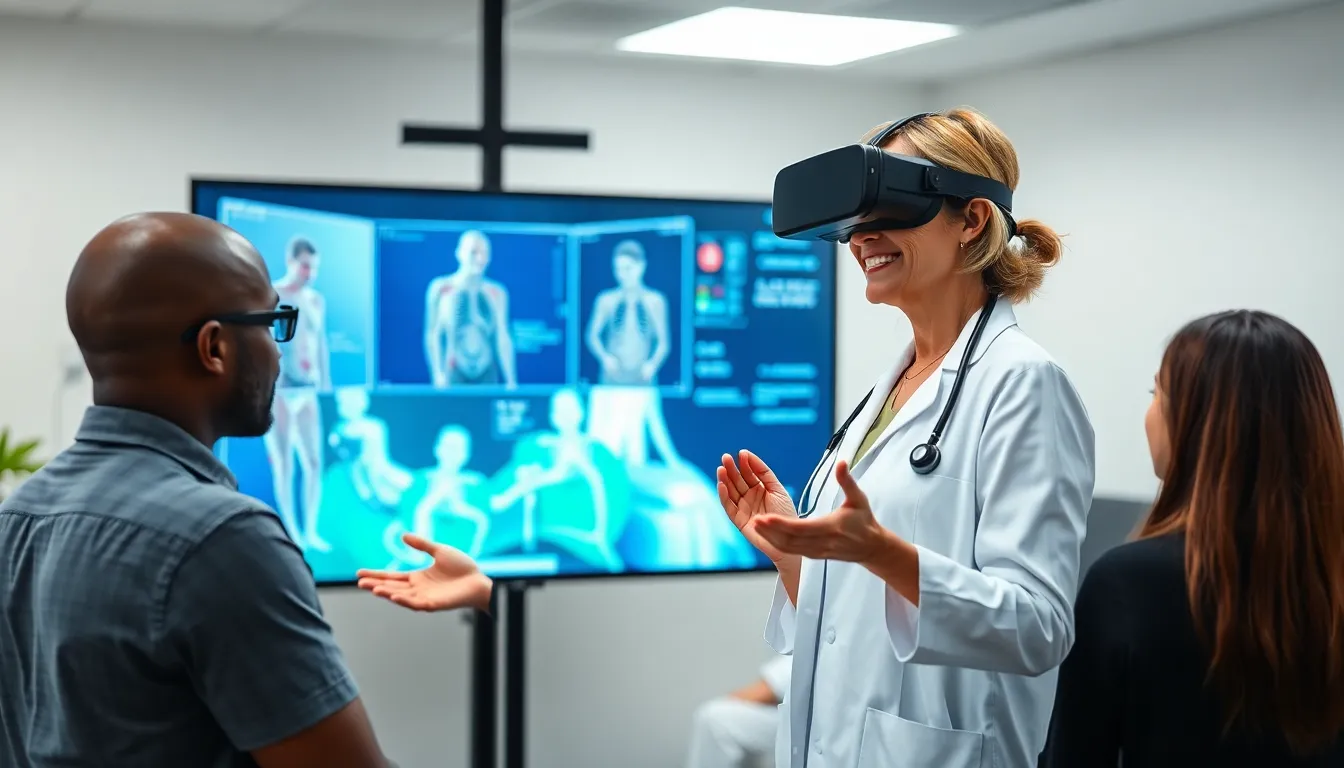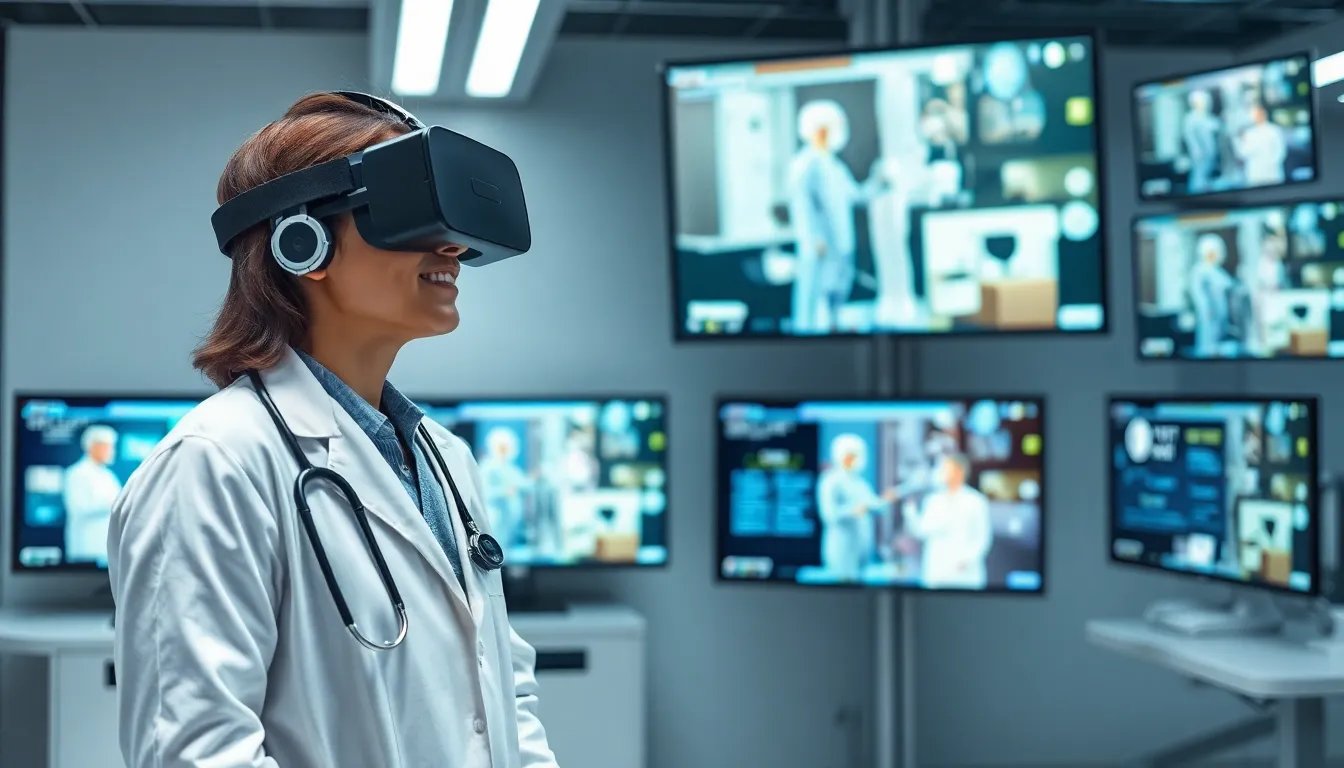Imagine a world where doctors can consult with patients from the comfort of their own homes, all while wearing a headset that makes them feel like they’re in a sci-fi movie. Welcome to the future of telemedicine, where virtual reality isn’t just for gaming anymore. It’s transforming healthcare into an immersive experience that’s as engaging as it is effective.
With VR in telemedicine, patients can step into a virtual clinic, chat with their physician, and even participate in interactive treatment sessions—all without leaving their couch. This tech isn’t just cool; it’s revolutionizing how healthcare is delivered, making it more accessible and less intimidating. As we dive deeper into the world of VR, it’s clear that the future of medicine is not just about healing; it’s about creating experiences that make patients feel like they’re part of the process.
Table of Contents
ToggleOverview of VR in Telemedicine
Virtual reality (VR) technology profoundly impacts telemedicine, creating dynamic interactions between patients and healthcare providers. Patients can wear VR headsets, accessing immersive environments that simulate real-world scenarios in a clinical setting. Such innovations lead to enhanced consultation experiences, where individuals feel more comfortable discussing health concerns.
VR empowers patients by providing interactive treatment options. For example, users can participate in virtual therapy sessions, engaging in exercises that target physical rehabilitation or mental health support. This technique fosters a sense of presence, enabling patients to connect with providers in meaningful ways.
Practitioners benefit from VR as well. They can utilize simulations for training purposes, enhancing skills in surgical procedures and patient interactions. Research indicates that 90% of healthcare professionals believe VR effectively improves their training experience. This technological advancement addresses skill gaps and builds confidence among practitioners.
Moreover, VR allows for remote monitoring of patients’ conditions. By incorporating VR into telehealth platforms, healthcare systems can track rehabilitation progress and adjust programs in real time. This capability leads to timely interventions, ultimately improving health outcomes for patients.
As VR in telemedicine continues to evolve, the focus remains on accessibility and patient-centered care. Enhanced connectivity opens doors, enabling individuals from remote areas to access healthcare resources. By integrating VR into telemedicine practices, the future of healthcare promises to be more inclusive and engaging, addressing patient needs effectively.
Benefits of VR in Telemedicine

Virtual reality (VR) in telemedicine presents numerous advantages, significantly altering patient experiences and health outcomes.
Enhanced Patient Engagement
Engagement in healthcare encounters improves with VR technology. Immersive environments entice patients, making consultations feel more like real-life interactions. Patients express heightened interest during virtual therapy sessions, which facilitates open communication about health concerns. Interaction through VR encourages patients to ask questions and participate in their treatment plans actively. Engaged patients understand their conditions better and relate more closely to the therapies prescribed. Providers notice higher satisfaction levels as patients experience less anxiety when discussing their health in a supportive virtual atmosphere.
Improved Patient Outcomes
Patient outcomes improve through VR applications in treatment plans. As immersive experiences can simulate real-world scenarios, patients practice coping strategies and therapeutic exercises in a controlled environment. Studies show that VR-based therapies often yield better adherence to rehabilitation programs. Healthcare teams monitor patient progress more efficiently, enabling timely adjustments that enhance the overall effectiveness of care. Furthermore, VR helps reduce recovery times and increases the likelihood of successful interventions. Remote interactions allow for continuous support, contributing to sustained improvements in health conditions and overall wellness.
Challenges and Limitations
VR in telemedicine faces several significant challenges and limitations that impact its integration and effectiveness. These hurdles can affect both healthcare providers and patients.
Technical Barriers
Technical barriers hinder the seamless implementation of VR in telemedicine. High costs associated with VR hardware and software limit accessibility for many healthcare facilities. Moreover, varying levels of technological infrastructure across regions can create disparities in service delivery. Bandwidth issues also pose challenges, as low internet speeds can disrupt immersive experiences. Lack of standardization among VR applications affects interoperability, complicating usage for practitioners. Ensuring user-friendly interfaces is essential for both patients and providers to minimize learning curves and maximize efficiency.
Ethical Considerations
Ethical considerations play a crucial role in the deployment of VR in telemedicine. Informed consent becomes complex when dealing with immersive environments, as patients may not fully understand the implications of these technologies. Privacy concerns arise with data collection and storage related to VR sessions. Ensuring patient confidentiality while utilizing immersive experiences can be challenging for providers. Another concern involves the potential for dependency on VR for treatment, which may not address underlying health issues. Continuous evaluation of ethical guidelines is necessary to foster trust and uphold the integrity of patient relationships in telemedicine.
Case Studies and Applications
The integration of VR into telemedicine showcases practical applications that enhance healthcare delivery. Key areas of implementation include surgical training and mental health therapy.
VR in Surgical Training
VR simulations provide a risk-free environment for surgical trainees. They allow practitioners to practice procedures without jeopardizing patient safety. Many training programs incorporate VR modules, enabling learners to hone skills and assess their proficiency in real-time. According to research, 80% of surgeons report improved dexterity after using VR for simulations. This technology not only boosts confidence but also prepares aspiring surgeons for high-stakes situations in actual operating rooms.
VR for Mental Health Therapy
Patients experiencing mental health issues benefit significantly from VR therapy. Virtual environments create immersive experiences that help patients confront anxiety and phobias in a controlled setting. Many therapists use VR to simulate scenarios that trigger stress, providing gradual exposure techniques. Research shows that patients receiving VR therapy experience a 30% reduction in anxiety symptoms. Such applications foster deeper engagement, allowing individuals to explore personal challenges while receiving guided support.
Future Trends in VR and Telemedicine
Emerging trends in virtual reality (VR) and telemedicine indicate a transformative shift in patient care. Increasingly, healthcare providers integrate VR environments to simulate clinical scenarios, enhancing both training and patient interaction. More healthcare professionals seek to incorporate VR into their practices, acknowledging its effectiveness, as 90% of practitioners affirm improvements in training outcomes.
Patients experience VR therapy sessions that allow for immersive interaction. Studies show that individuals undergoing VR therapy report a 30% reduction in anxiety symptoms while confronting fears in controlled settings. Innovative VR applications appear in areas such as remote monitoring, where providers can make real-time adjustments to rehabilitation programs, improving patient engagement.
Developments also focus on enhancing VR technology for surgical training. Training environments that nurture skills without risk contribute significantly to safety in actual procedures. Eighty percent of surgeons identify improved dexterity through VR simulations, positioning VR as vital for effective surgical education.
Investments in VR technology indicate a forward momentum toward overcoming challenges. Technical obstacles include high costs, varied infrastructure, and bandwidth issues, but continuous innovations aim to address these limitations. Ethical considerations require ongoing evaluation, particularly regarding informed consent and privacy. Patients and providers alike benefit from a commitment to maintaining trust while navigating the ethical complexities of VR in telemedicine.
Greater accessibility to VR tools drives the potential for widespread acceptance in healthcare. Telemedicine combined with VR fosters patient-centered care, allowing individuals to engage deeply in their health journeys. As VR technology advances, healthcare can evolve into a more inclusive and interactive experience for all.
The integration of VR in telemedicine marks a significant advancement in healthcare delivery. By creating immersive environments for both patients and providers, it fosters meaningful interactions that enhance the overall experience. This technology empowers patients to take an active role in their health while equipping practitioners with valuable training tools.
As VR continues to evolve, its potential to transform telemedicine becomes increasingly evident. The focus on patient engagement and improved outcomes illustrates a future where healthcare is not only accessible but also personalized. With ongoing investments and innovations in this field, VR is set to redefine the boundaries of patient care and support a more collaborative approach to health management.

